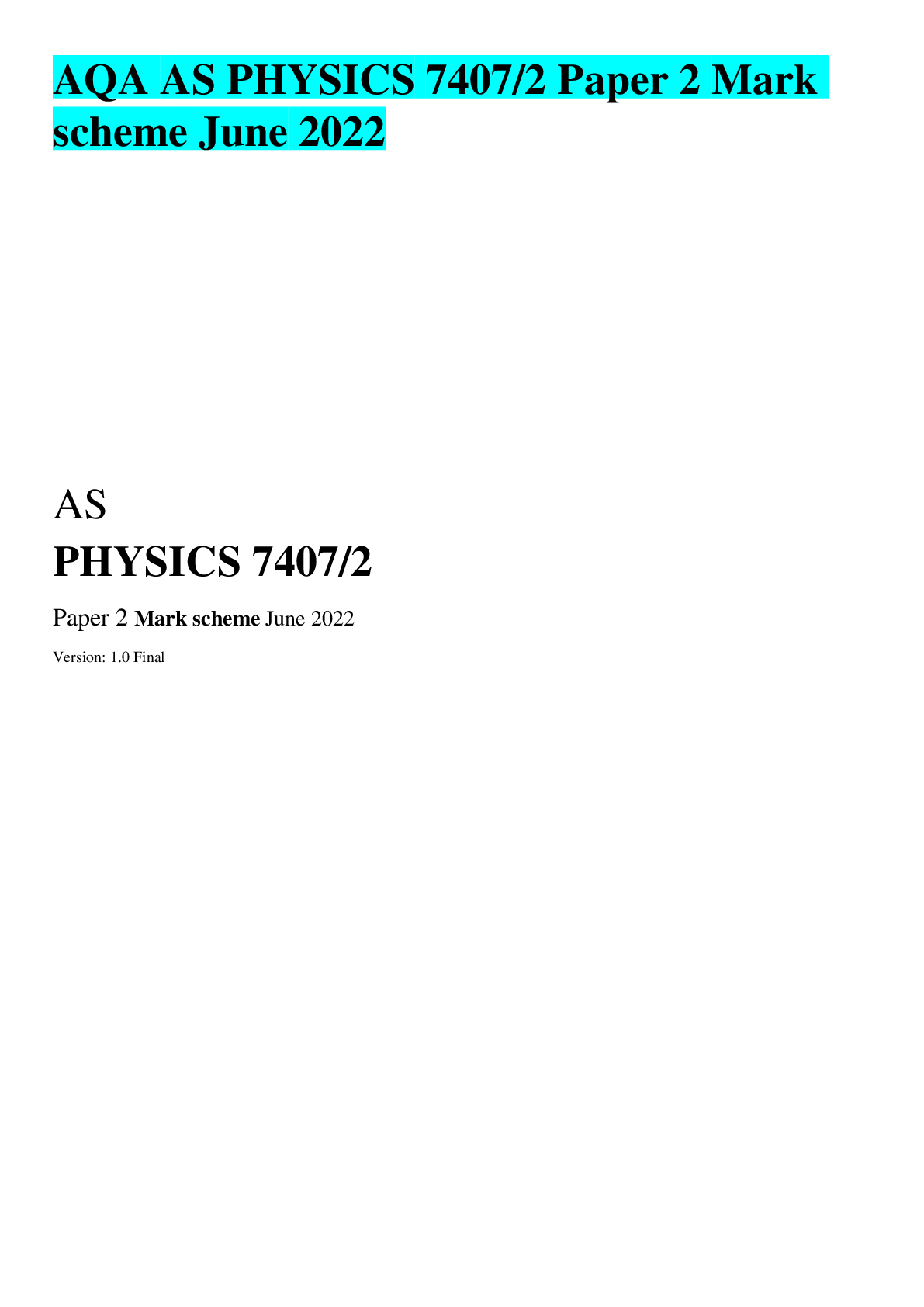Mathematics > AS Level Mark Scheme > A-level MATHEMATICS 7357/2 Paper 2 Mark scheme June 2022 (All)
A-level MATHEMATICS 7357/2 Paper 2 Mark scheme June 2022
Document Content and Description Below
Version: 1.0 Final Mark Scheme *226A7357/2/MS* MARK SCHEME – A-LEVEL MATHEMATICS – 7357/2 – JUNE 2022 2 Mark schemes are prepared by the Lead Assessment Writer and considered, together with... the relevant questions, by a panel of subject teachers. This mark scheme includes any amendments made at the standardisation events which all associates participate in and is the scheme which was used by them in this examination. The standardisation process ensures that the mark scheme covers the students’ responses to questions and that every associate understands and applies it in the same correct way. As preparation for standardisation each associate analyses a number of students’ scripts. Alternative answers not already covered by the mark scheme are discussed and legislated for. If, after the standardisation process, associates encounter unusual answers which have not been raised they are required to refer these to the Lead Examiner. It must be stressed that a mark scheme is a working document, in many cases further developed and expanded on the basis of students’ reactions to a particular paper. Assumptions about future mark schemes on the basis of one year’s document should be avoided; whilst the guiding principles of assessment remain constant, details will change, depending on the content of a particular examination paper. Further copies of this mark scheme are available from aqa.org.uk Copyright information AQA retains the copyright on all its publications. However, registered schools/colleges for AQA are permitted to copy material from this booklet for their own internal use, with the following important exception: AQA cannot give permission to schools/colleges to photocopy any material that is acknowledged to a third party even for internal use within the centre. Copyright © 2022 AQA and its licensors. All rights reserved. MARK SCHEME – A-LEVEL MATHEMATICS – 7357/2 – JUNE 2022 3 Mark scheme instructions to examiners General The mark scheme for each question shows: • the marks available for each part of the question • the total marks available for the question • marking instructions that indicate when marks should be awarded or withheld including the principle on which each mark is awarded. Information is included to help the examiner make his or her judgement and to delineate what is creditworthy from that not worthy of credit • a typical solution. This response is one we expect to see frequently. However credit must be given on the basis of the marking instructions. If a student uses a method which is not explicitly covered by the marking instructions the same principles of marking should be applied. Credit should be given to any valid methods. Examiners should seek advice from their senior examiner if in any doubt. Key to mark types M mark is for method R mark is for reasoning A mark is dependent on M marks and is for accuracy B mark is independent of M marks and is for method and accuracy E mark is for explanation F follow through from previous incorrect result Key to mark scheme abbreviations CAO correct answer only CSO correct solution only ft follow through from previous incorrect result ‘their’ Indicates that credit can be given from previous incorrect result AWFW anything which falls within AWRT anything which rounds to ACF any correct form AG answer given SC special case OE or equivalent NMS no method shown PI possibly implied sf significant figure(s) dp decimal place(s) MARK SCHEME – A-LEVEL MATHEMATICS – 7357/2 – JUNE 2022 4 AS/A-level Maths/Further Maths assessment objectives AO Description AO1 AO1.1a Select routine procedures AO1.1b Correctly carry out routine procedures AO1.2 Accurately recall facts, terminology and definitions AO2 AO2.1 Construct rigorous mathematical arguments (including proofs) AO2.2a Make deductions AO2.2b Make inferences AO2.3 Assess the validity of mathematical arguments AO2.4 Explain their reasoning AO2.5 Use mathematical language and notation correctly AO3 AO3.1a Translate problems in mathematical contexts into mathematical processes AO3.1b Translate problems in non-mathematical contexts into mathematical processes AO3.2a Interpret solutions to problems in their original context AO3.2b Where appropriate, evaluate the accuracy and limitations of solutions to problems AO3.3 Translate situations in context into mathematical models AO3.4 Use mathematical models AO3.5a Evaluate the outcomes of modelling in context AO3.5b Recognise the limitations of models AO3.5c Where appropriate, explain how to refine models MARK SCHEME – A-LEVEL MATHEMATICS – 7357/2 – JUNE 2022 5 Examiners should consistently apply the following general marking principles No Method Shown Where the question specifically requires a particular method to be used, we must usually see evidence of use of this method for any marks to be awarded. Where the answer can be reasonably obtained without showing working and it is very unlikely that the correct answer can be obtained by using an incorrect method, we must award full marks. However, the obvious penalty to students showing no working is that incorrect answers, however close, earn no marks. Where a question asks the student to state or write down a result, no method need be shown for full marks. Where the permitted calculator has functions which reasonably allow the solution of the question directly, the correct answer without working earns full marks, unless it is given to less than the degree of accuracy accepted in the mark scheme, when it gains no marks. Otherwise we require evidence of a correct method for any marks to be awarded. Diagrams Diagrams that have working on them should be treated like normal responses. If a diagram has been written on but the correct response is within the answer space, the work within the answer space should be marked. Working on diagrams that contradicts work within the answer space is not to be considered as choice but as working, and is not, therefore, penalised. Work erased or crossed out Erased or crossed out work that is still legible and has not been replaced should be marked. Erased or crossed out work that has been replaced can be ignored. Choice When a choice of answers and/or methods is given and the student has not clearly indicated which answer they want to be marked, mark positively, awarding marks for all of the student's best attempts. Withhold marks for final accuracy and conclusions if there are conflicting complete answers or when an incorrect solution (or part thereof) is referred to in the final answer. MARK SCHEME – A-LEVEL MATHEMATICS – 7357/2 – JUNE 2022 6 Q Marking instructions AO Marks Typical solution 1 Ticks correct box 1.1b B1 ( ) ( ) 2 2 x y − ++ = 4 5 36 Question 1 Total 1 Q Marking instructions AO Marks Typical solution 2 Circles correct answer 2.2a R1 –1 Question 2 Total 1 Q Marking instructions AO Marks Typical solution 3 Ticks correct box 1.2 B1 Question 3 Total 1 MARK SCHEME – A-LEVEL MATHEMATICS – 7357/2 – JUNE 2022 7 Q Marking instructions AO Marks Typical solution 4 Uses the sine rule Or Substitutes correctly into the cosine rule 1.1a M1 sin sin38 8.7 6.1 θ = . . . ... 61 4 180 61 4 118 58 119 A θ = = − = = Obtains a value of 61 or 61.410964… rounded or truncated Condone answer (in radians) of 1.0718… or 0.4364… PI by correct obtuse angle or 81 Or Obtains correct length AB = 3.9367… Or 2 AB 15.4998... = 1.1b A1 Deduces the largest angle is 119 AWRT CAO 2.2a A1 Question 4 Total 3 MARK SCHEME – A-LEVEL MATHEMATICS – 7357/2 – JUNE 2022 8 Q Marking instructions AO Marks Typical solution 5(a) Obtains 16 Not incorrectly labelled 1.1b B1 ( x xx ) x x + =+ + + + 4 2 3 4 2 5 16 160 600 1000 625 A = 16 Obtains 600 B = 600 Not incorrectly labelled 1.1b B1 Subtotal 2 Q Marking instructions AO Marks Typical solution 5(b) Obtains the expansion of ( − x) 4 2 5 = A x Bx x x − +− + 2 34 160 1000 625 Accept A and B unsubstituted or their A and B Or Uses a valid method and obtains one of C = 320 or D = 2000 1.1a M1 ( ) ( ) ( ) x x xx x x xx x x x x + −− =+ + + + −− + − + = + 4 4 2 34 2 34 3 25 25 16 160 600 1000 625 16 160 600 1000 625 320 2000 Completes reasoned argument to show ( + −− = + x x xx ) ( ) 4 4 3 2 5 2 5 320 2000 Accept A and B unsubstituted or their A and B Must finish with x x + 3 320 2000 don’t accept just C=320 and D = 2000 2.1 R1F Subtotal 2 MARK SCHEME – A-LEVEL MATHEMATICS – 7357/2 – JUNE 2022 9 Q Marking instructions AO Marks Typical solution 5(c) Integrates one term correctly Accept C and D unsubstituted or their C and D Or Uses reverse of chain rule to obtain at least one term of the form ( ) 1 , or 25 P xP ± =± ± 5 1 2 5 5 1.1a M1 (( ) ( ) ) ( ) d d x xx x xx x xc + −− = + =++ ∫ ∫ 4 4 3 2 4 25 25 320 2000 Obtains x xc 2 4 + + 160 500 320 2000 2 4 FT C and D unsubstituted or their C and D Or ( x x ) ( ) c + − + + × × 5 5 25 25 55 55 Condone missing +c 1.1b A1F Subtotal 2 Question 5 Total 6 MARK SCHEME – A-LEVEL MATHEMATICS – 7357/2 – JUNE 2022 10 Q Marking instructions AO Marks Typical solution 6(a) Squares a number with two or more digits and adds its digits. Must be explicit 1.1a M1 = + = ≠ 2 12 144 12 3 3 4 Completes argument to show that Asif’s method is incorrect Must compare sum of digits with last digit of square number 2.3 R1 Subtotal 2 Q Marking instructions AO Marks Typical solution 6(b) Obtains 1 1.1b B1 1 Subtotal 1 Q Marking instructions AO Marks Typical solution 6(c) Lists at least four single digits and their squares Or Explains why odd digits do not need to be considered 1.1a M1 Therefore, there can be no square number which has a last digit of 8 = = = = 2 2 2 2 0 0 1 1 2 4 3 9 = = = = 2 2 2 2 4 16 5 25 6 36 7 49 = = 2 2 8 64 9 81 Completes rigorous argument to prove that no square number has a last digit of 8 OE CSO 2.1 R1 Subtotal 2 Question 6 Total 5 MARK SCHEME – A-LEVEL MATHEMATICS – 7357/2 – JUNE 2022 11 Q Marking instructions AO Marks Typical solution 7(a) Identifies the height of the triangle or rectangle as 2 15 − q PI by ( ) 2 q q ,15 − , 2 h q = − 15 or 2 y q = − 15 may be indicated on diagram 3.1a M1 ?? = 1 2 × 2??(15 − ??2) = 15?? − ??3 Since ?? = ??(15 − ??2) > 0 then ??’s upper limit ?? = √15 Completes rigorous argument to show the given result. It must be clear how they have defined the base and height with use of 1 2 × 2??(15 − ??2) for whole triangle Or � 1 2 ??(15 − ??2)� × 2 for two half triangles Or Explains why the area of the triangle is given by ??(15 − ??2) with reference to the rectangle on either side of y-axis 2.1 R1 Deduces ?? = √15 ACF 2.2a B1 Subtotal 3 MARK SCHEME – A-LEVEL MATHEMATICS – 7357/2 – JUNE 2022 12 Q Marking instructions AO Marks Typical solution 7(b) Explains that maximum occurs when derivative equals 0 Condone incorrect variables in their derivative 2.4 E1 ???? ???? = 15 − 3??2 max occurs at ???? ???? = 0 15 − 3??2 = 0 ?? = √5 2 2 d 65 0 d A q =− < so local maximum ∴Max area = 15 5 5 5 10 5 − = Differentiates w.r.t. q At least one term correct 3.1a M1 Obtains 2 15 3 − q 1.1b A1 Solves ‘their d d A q ’ = 0 to find q and substitutes to find maximum area 1.1a M1 Obtains correct maximum area ACF 1.1b A1 Gives justification for maximum Could be evaluation of second derivative as -13.42…< 0 Or Test of gradient either side, Or Explanation, for example: This must be a max value as only turning point in the interval 0 < ?? < √15 and the area is 0 at the endpoints 2.4 E1 Subtotal 6 Question 7 Total 9 MARK SCHEME – A-LEVEL MATHEMATICS – 7357/2 – JUNE 2022 13 Q Marking instructions AO Marks Typical solution 8(a) Sketches a branch of the curve with correct shape in 1st or 2nd quadrant with correct asymptotes and not touching the axes 1.2 M1 Sketches a fully correct curve with correct asymptotes and not touching the axes 1.1b A1 Subtotal 2 Q Marking instructions AO Marks Typical solution 8(b) Describes a stretch of scale factor 3 or 9 in either direction 2.4 M1 The curve can be stretched in the y-direction by a scale factor of 9 The curve can be stretched in the x-direction by a scale factor of 3 Beth and Paul are both correct. Explains that the curve can be stretched in the y-direction by a scale factor of 9 Scale factor PI by 9f ( x) OR Explains that the curve can be stretched in the x-direction by a scale factor of 3 Scale factor PI by f 3 x 2.4 A1 Explains that the curve can be stretched in the y-direction by a scale factor of 9 PI by 9f ( x) AND Explains that the curve can be stretched in the x-direction by a scale factor of 3 PI by f 3 x AND Concludes both are correct 2.2a R1 Subtotal 3 Question 8 Total 5 MARK SCHEME – A-LEVEL MATHEMATICS – 7357/2 – JUNE 2022 14 Q Marking instructions AO Marks Typical solution 9 Uses a log (or index) law correctly on an algebraic term log log log A B n A ± 1.1b B1 x y x y x y x y x y − = [Show More]
Last updated: 2 years ago
Preview 1 out of 29 pages
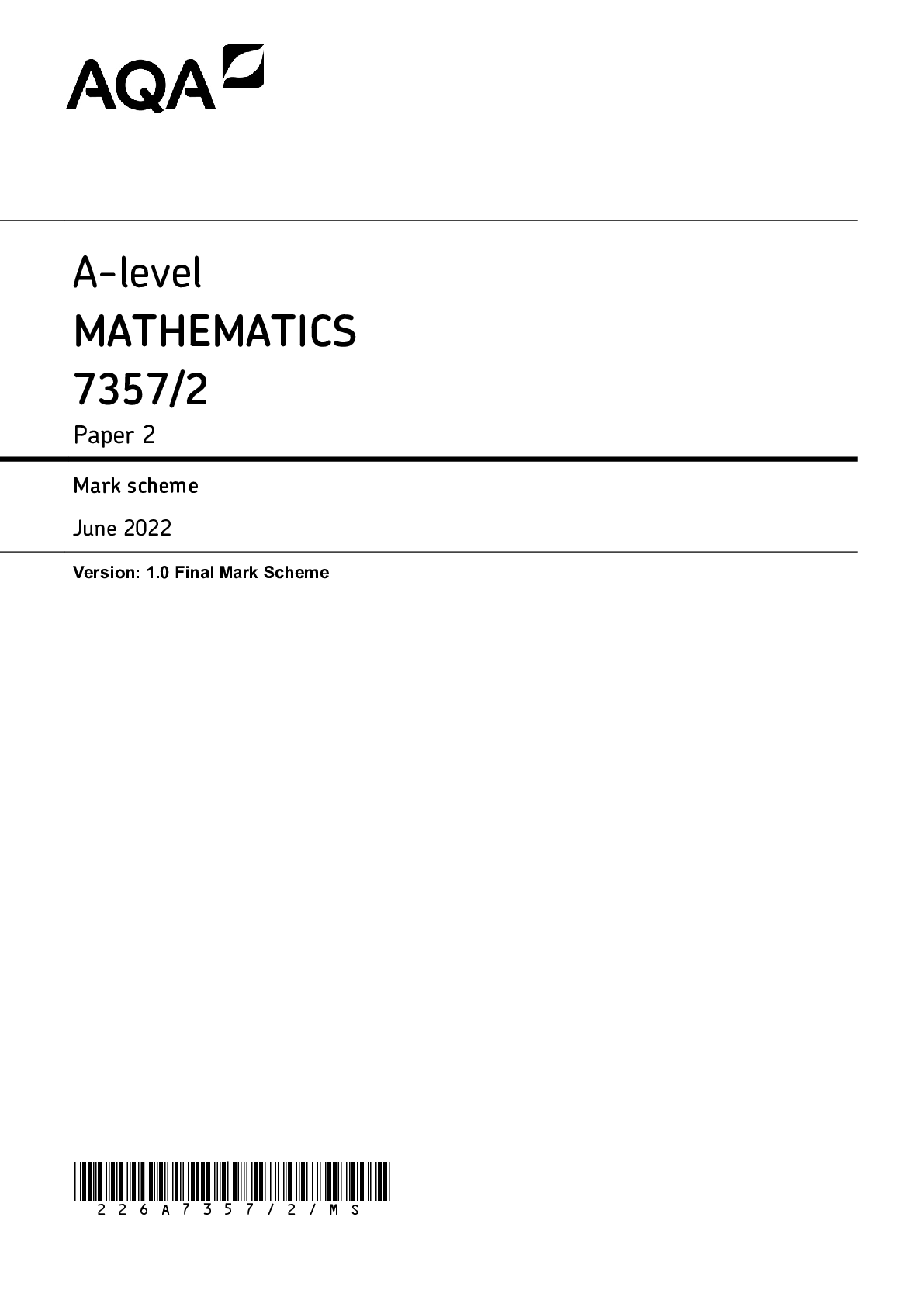
Buy this document to get the full access instantly
Instant Download Access after purchase
Buy NowInstant download
We Accept:

Reviews( 0 )
$9.00
Can't find what you want? Try our AI powered Search
Document information
Connected school, study & course
About the document
Uploaded On
Apr 01, 2023
Number of pages
29
Written in
Additional information
This document has been written for:
Uploaded
Apr 01, 2023
Downloads
0
Views
115

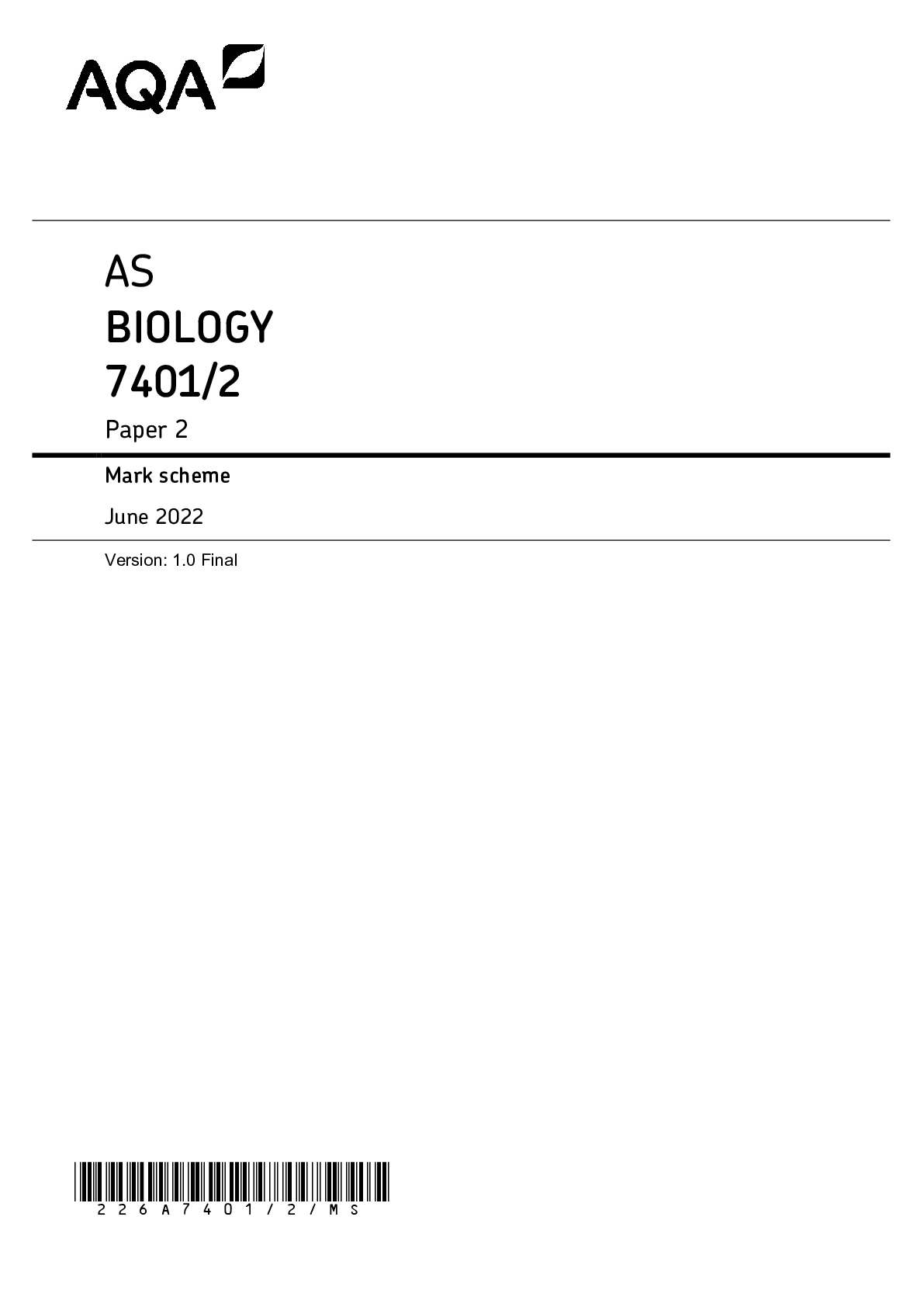
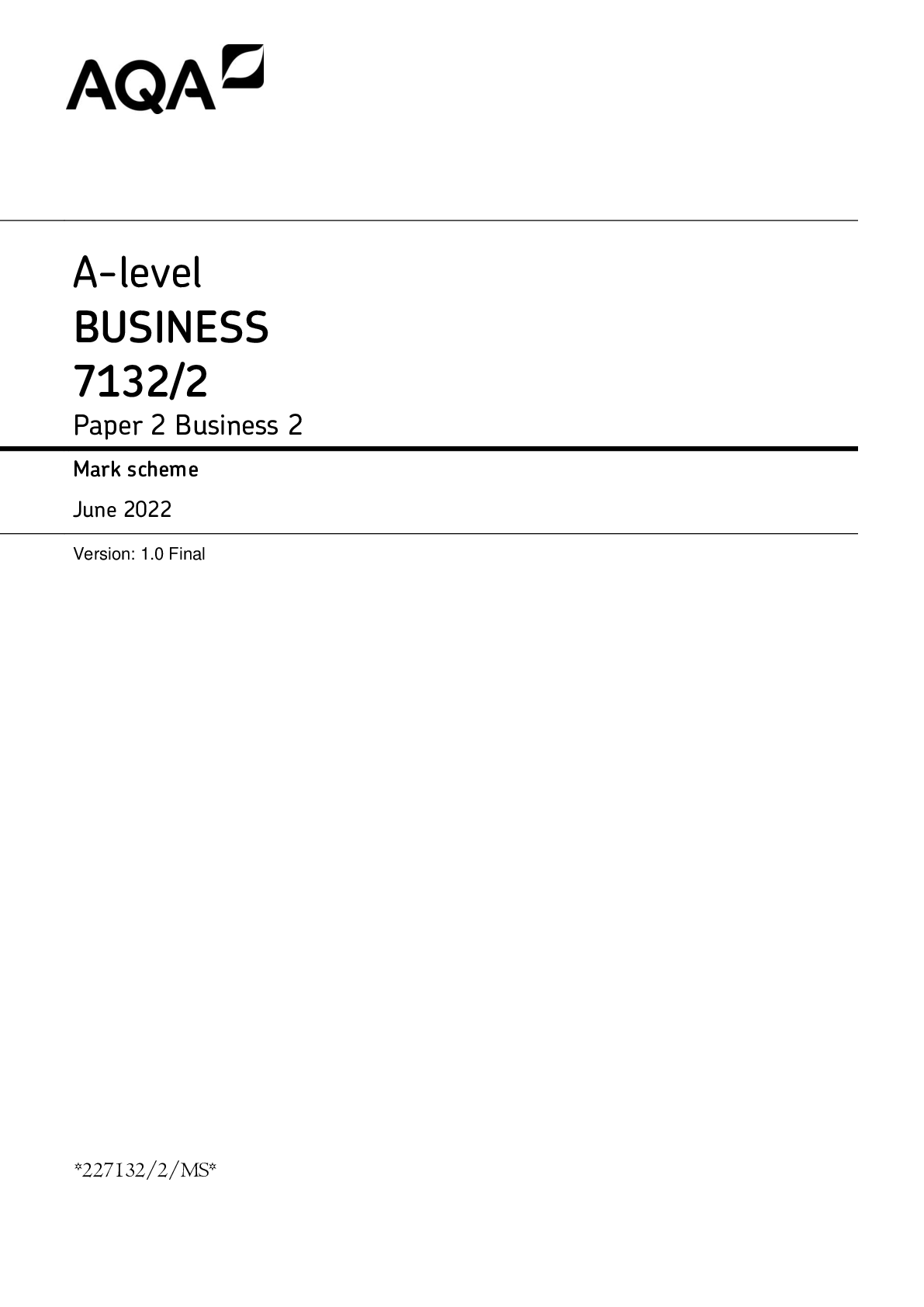
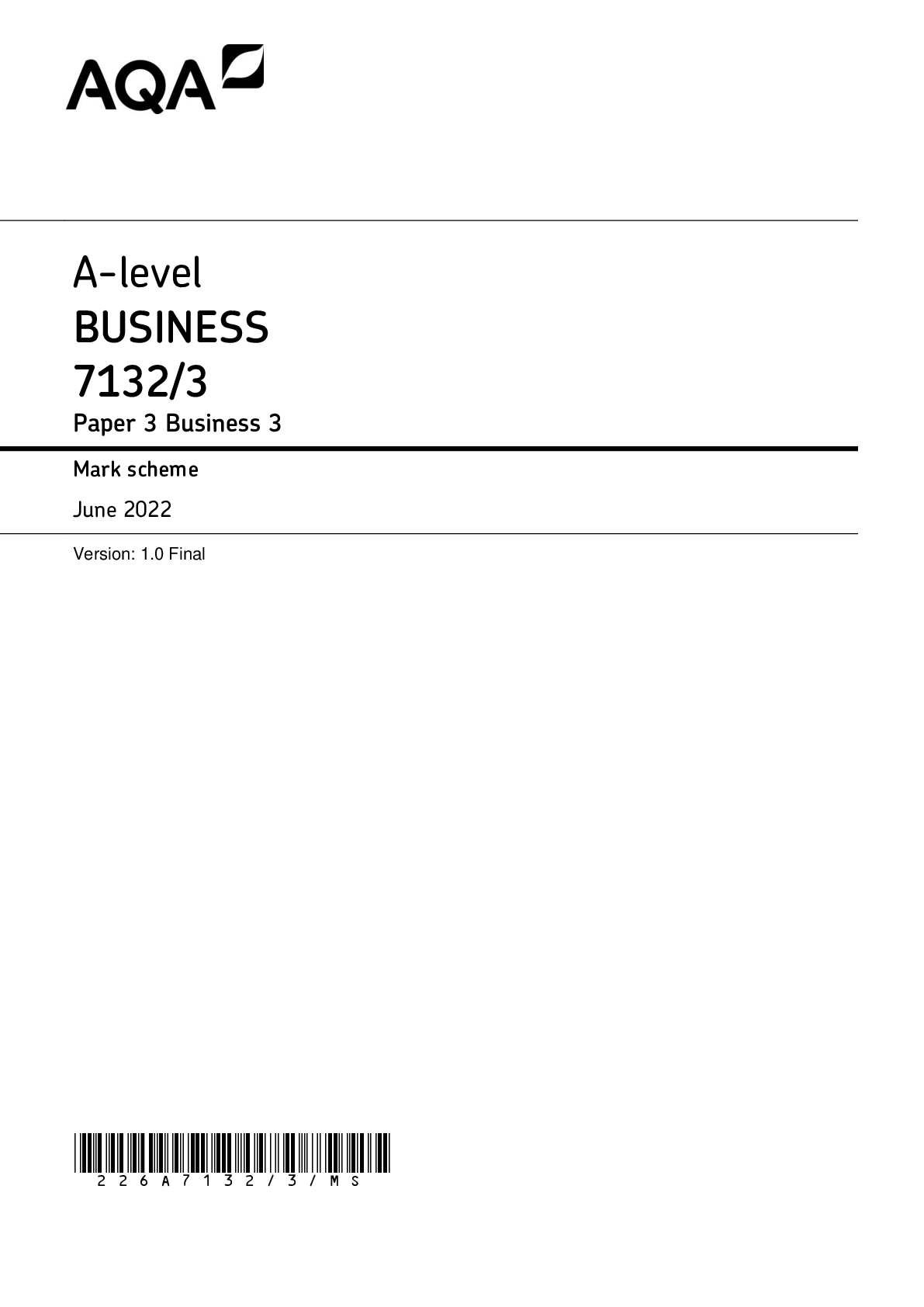
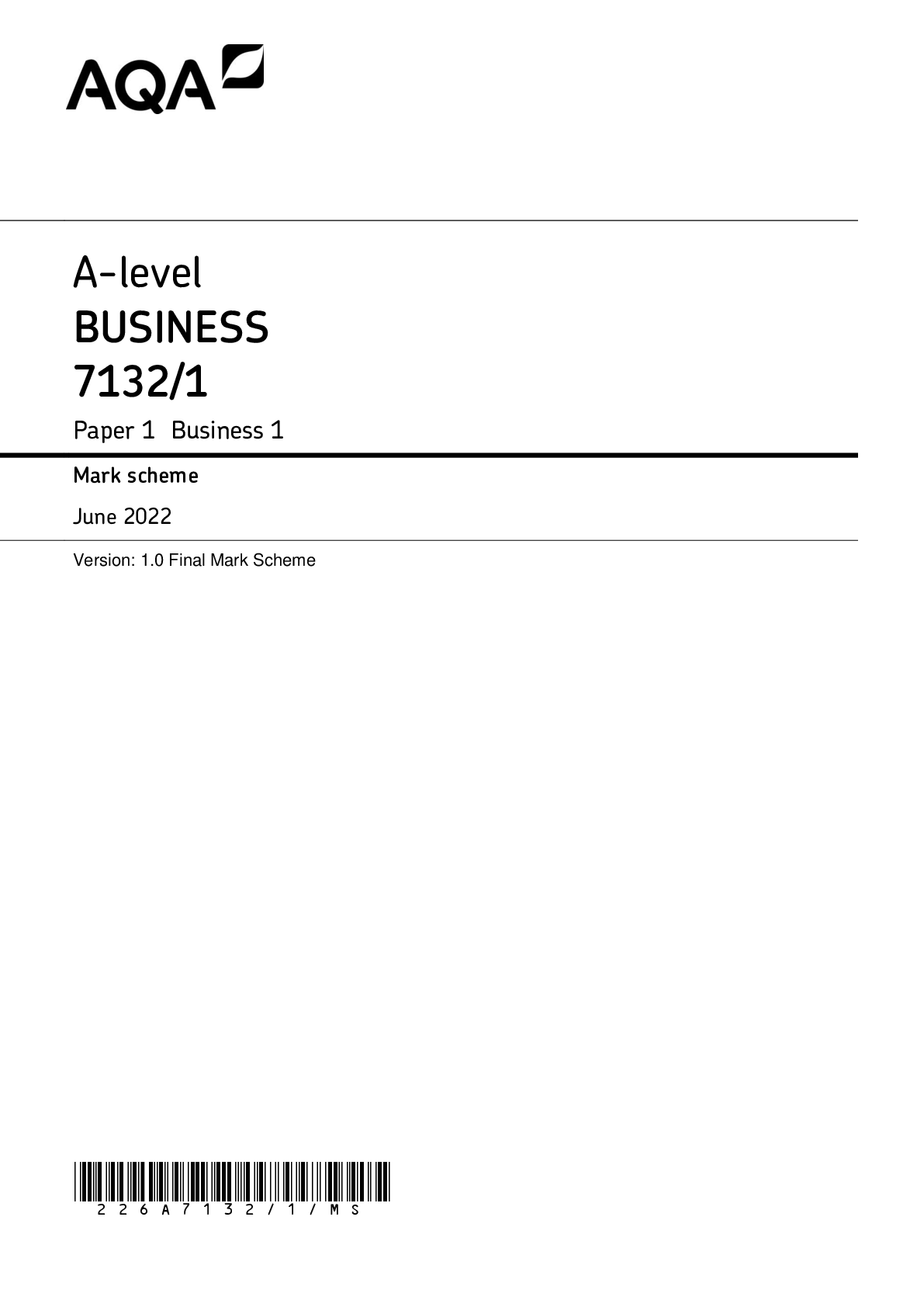
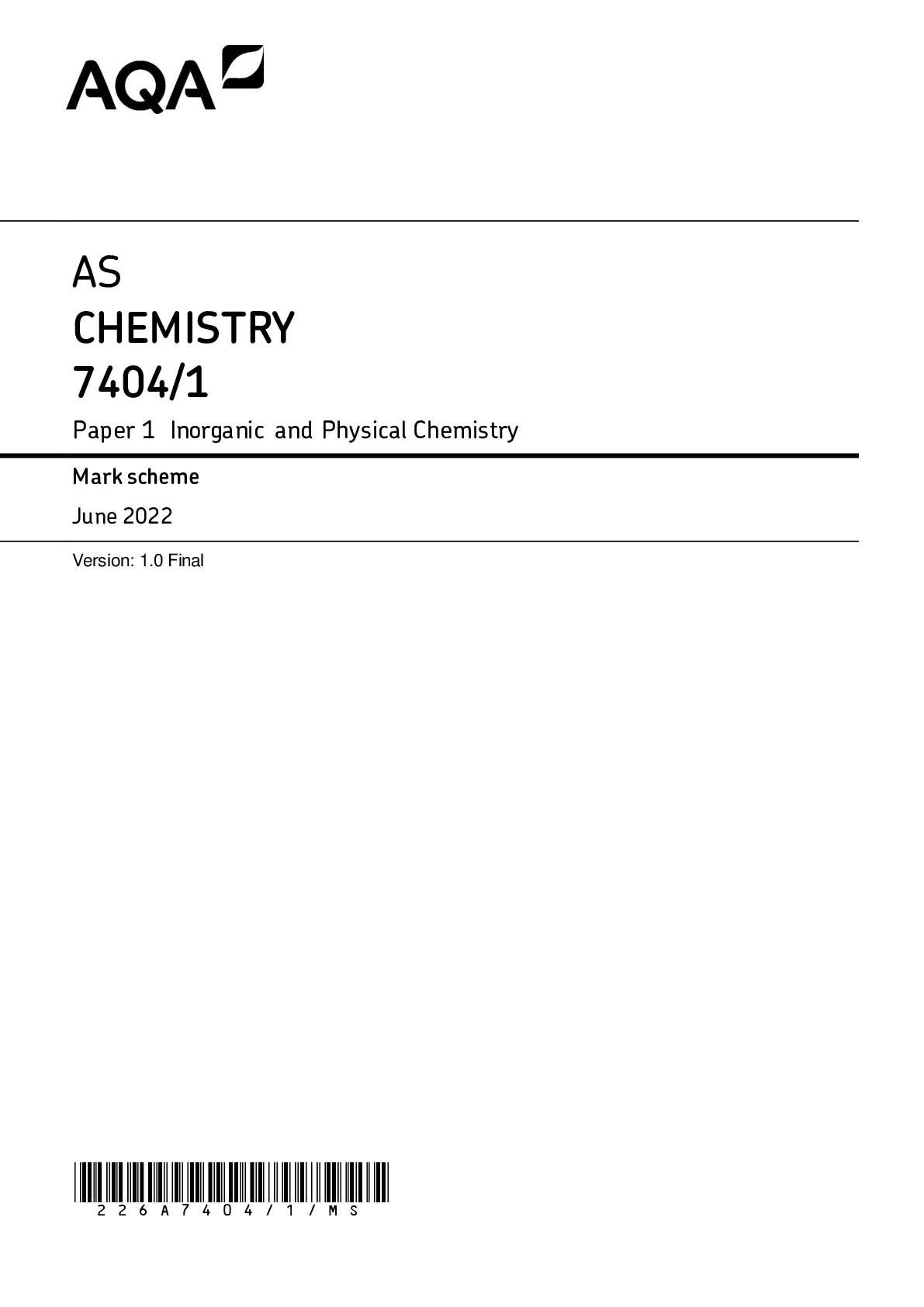

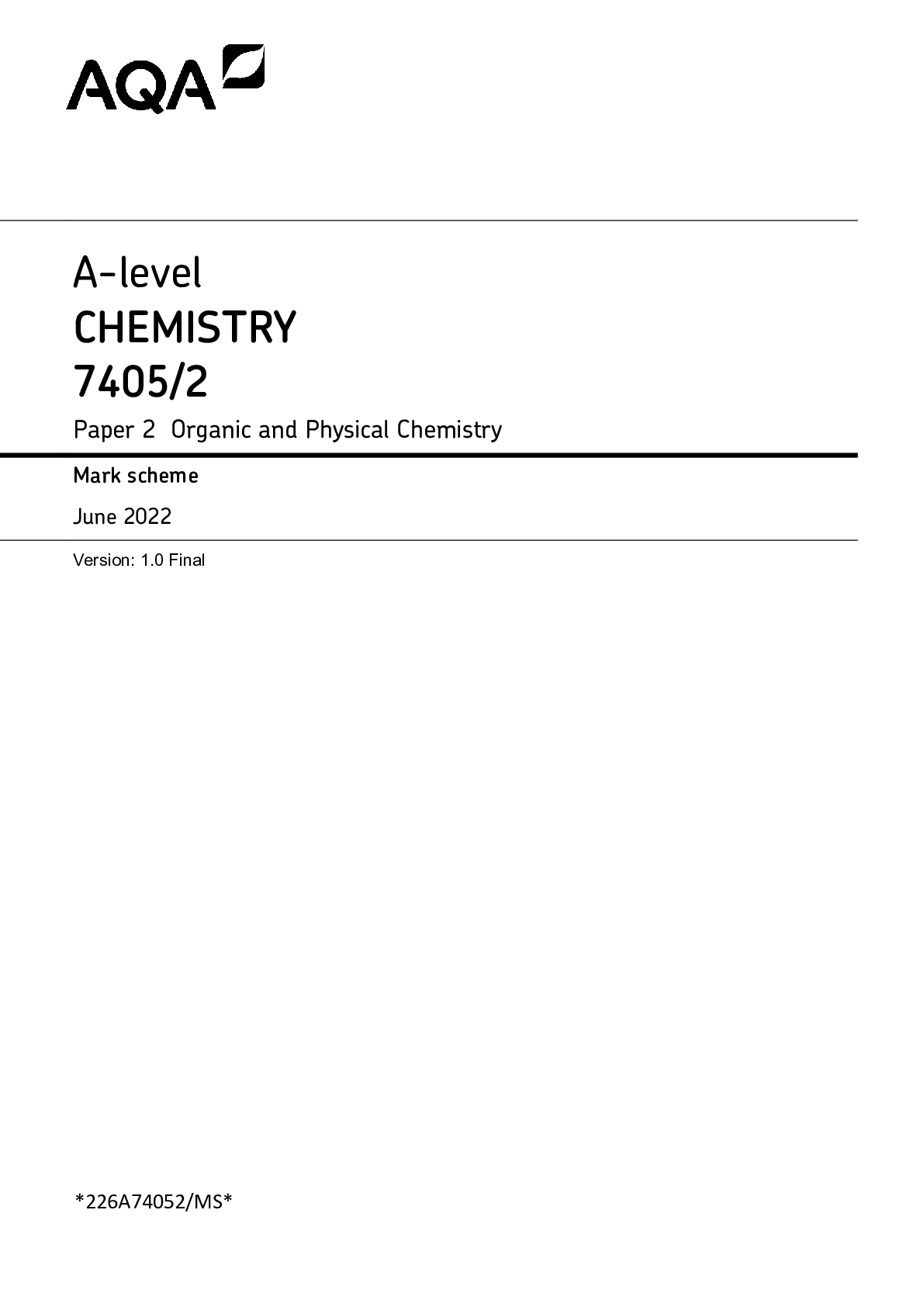
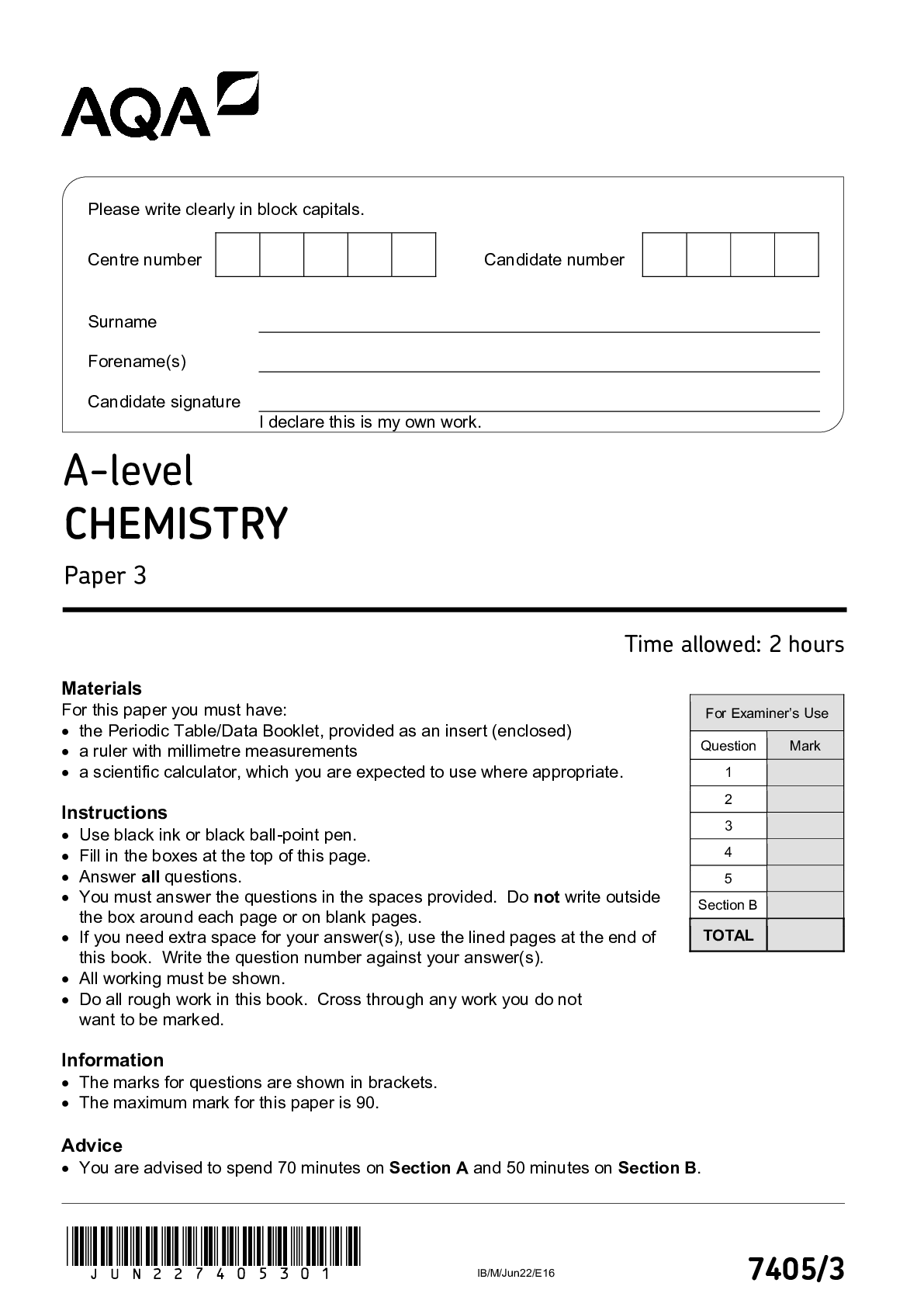

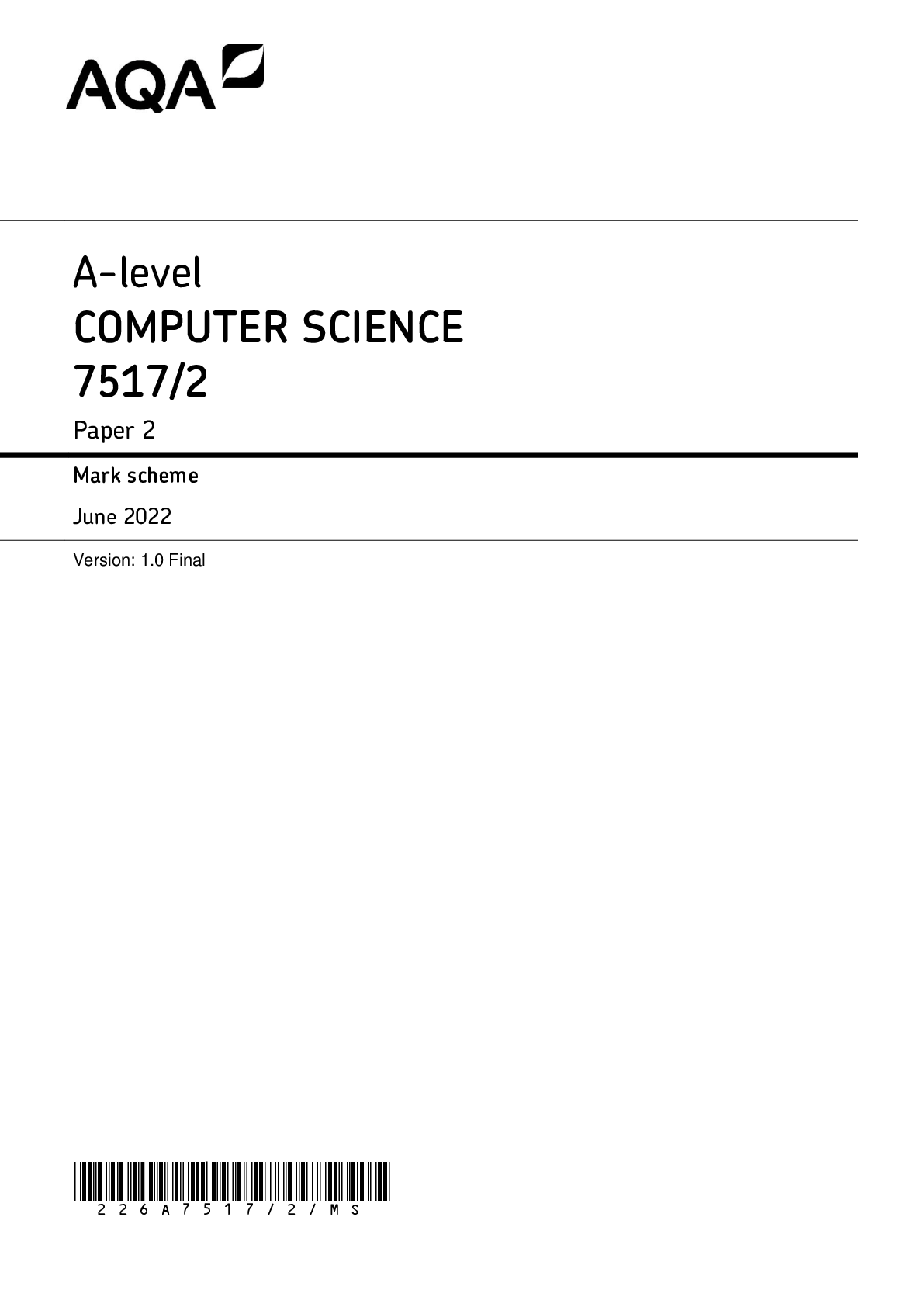
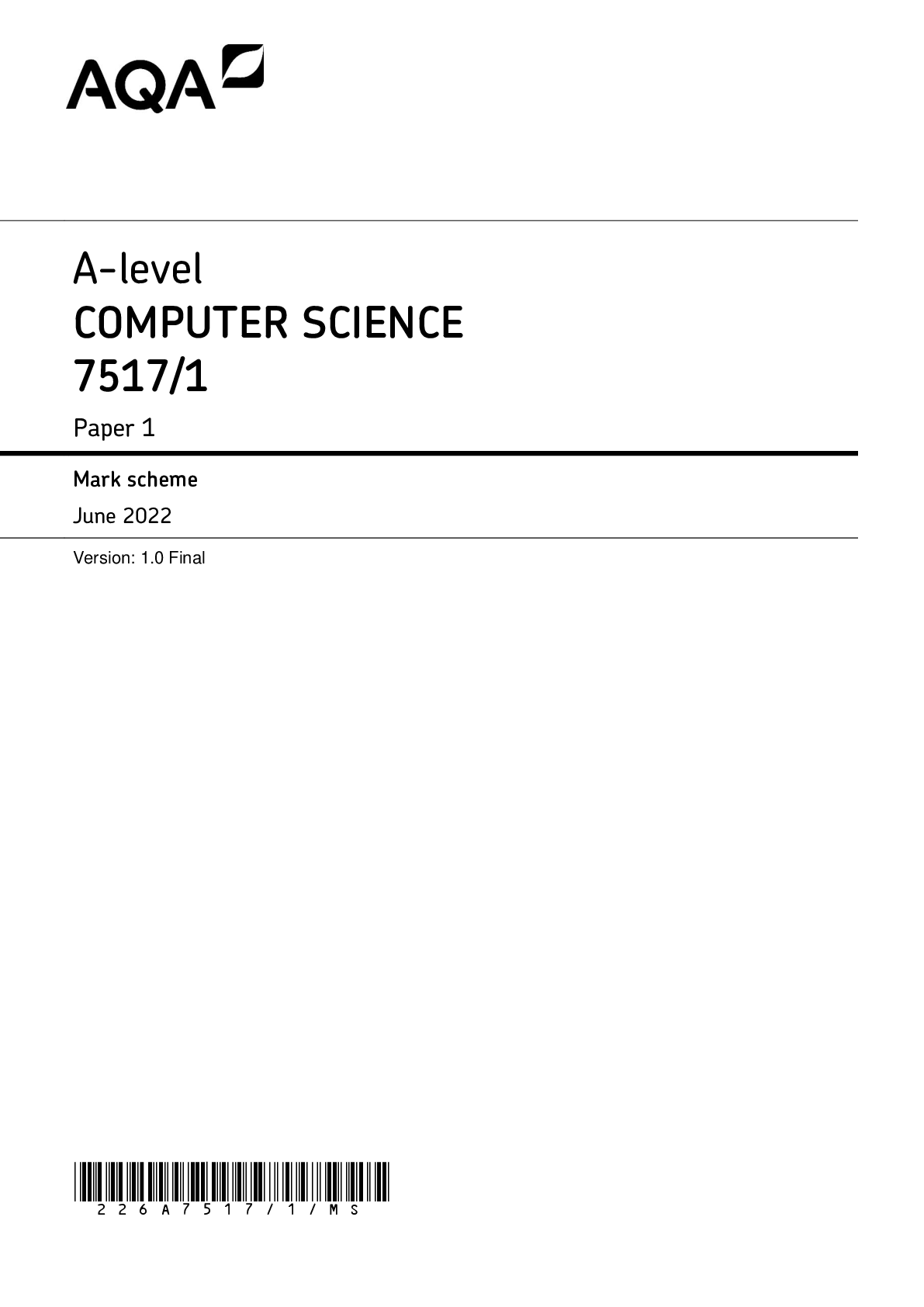

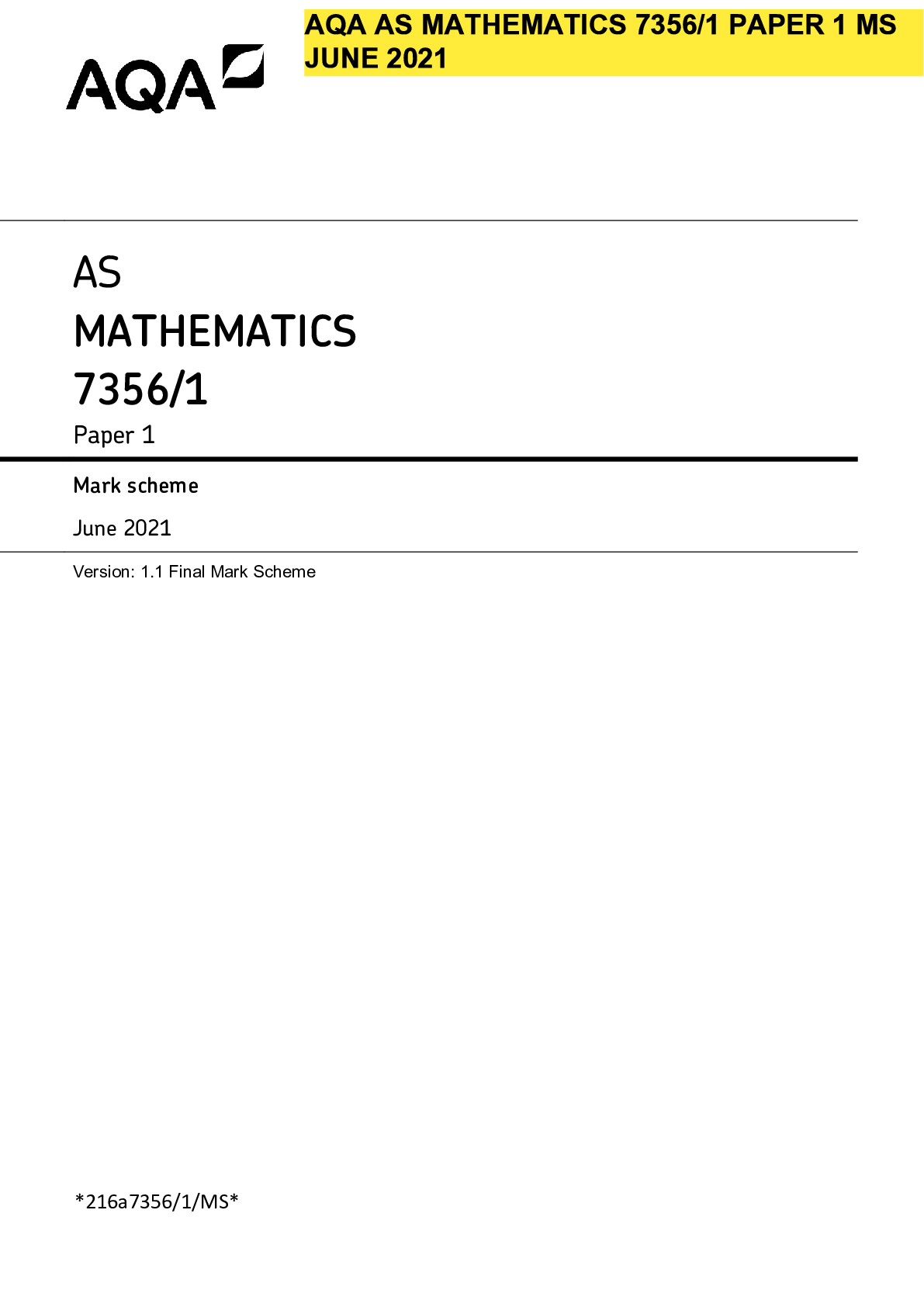

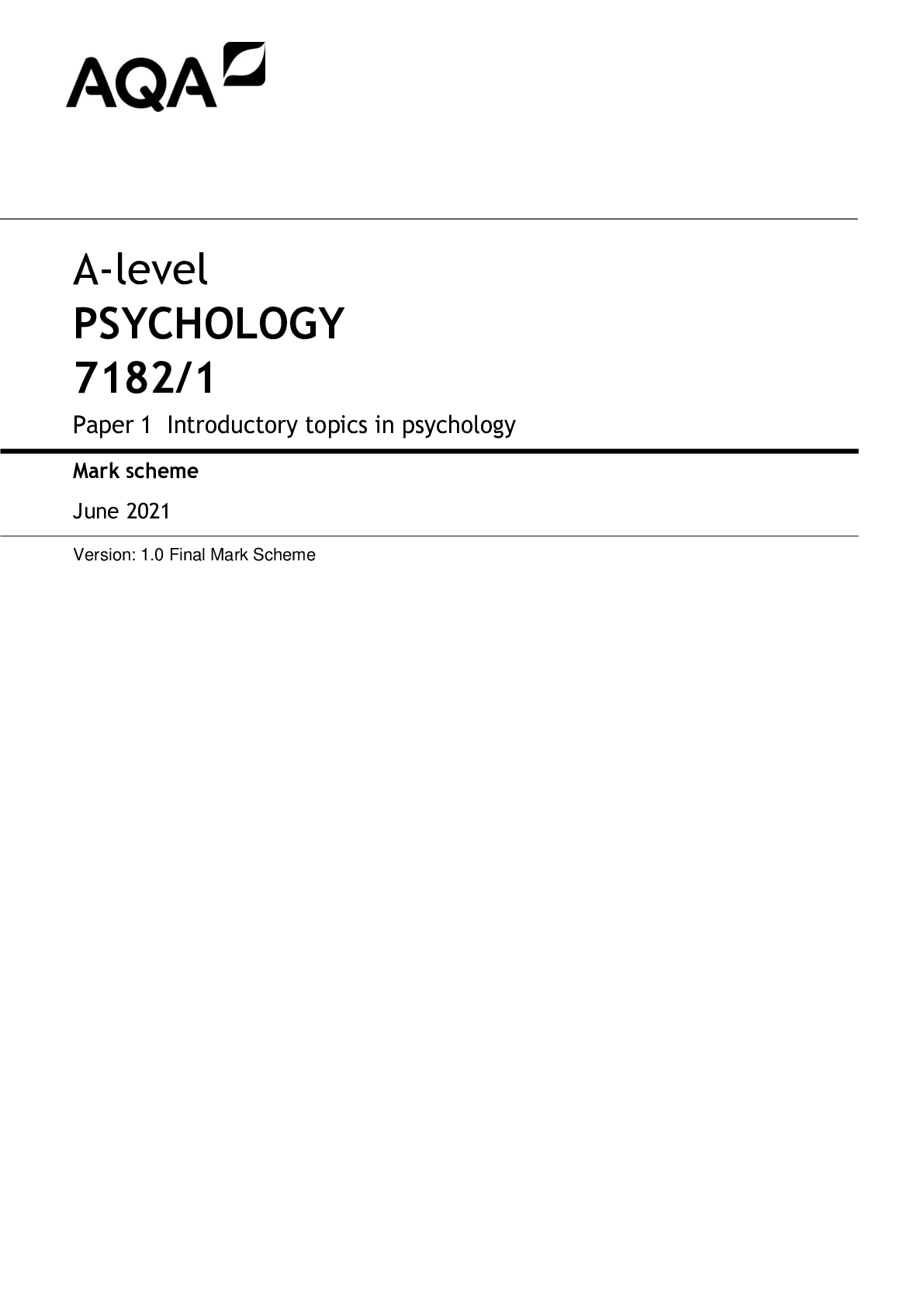

.png)
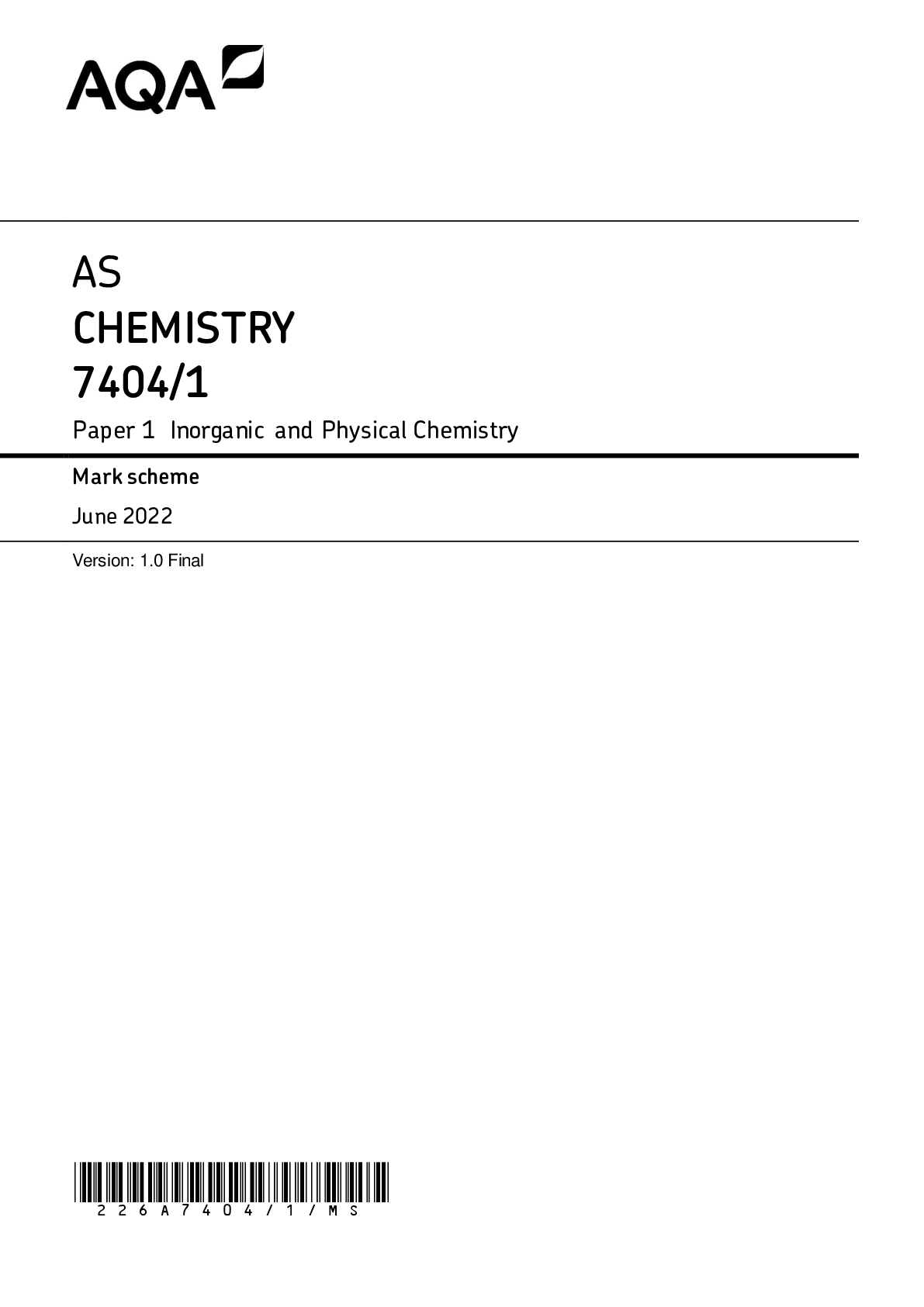

.png)
